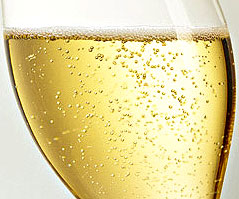 Sparkling Wine is a wine with significant levels of carbon dioxide in it making it fizzy. The carbon dioxide may result from natural fermentation, (either in a bottle, as with the methode champenoise, or in a large tank designed to withstand the pressures involved, as in the Charmat process) or as a result of carbon dioxide injection.
Sparkling Wine is a wine with significant levels of carbon dioxide in it making it fizzy. The carbon dioxide may result from natural fermentation, (either in a bottle, as with the methode champenoise, or in a large tank designed to withstand the pressures involved, as in the Charmat process) or as a result of carbon dioxide injection.
The United States is a significant producer of sparkling wine: California in particular is famous for its rose sparklers. Recently the United Kingdom has started producing Champagne-style wines. Sparkling wine is usually white or rose but there are many examples of red Australian sparkling Shiraz, some of high quality.
Some wines are made only lightly sparkling, such as vinho verde in Portugal — such wines are often called frizzante or petillant, or simply semi-sparkling wines. Sparkling Wines as opposed to Semi-Sparkling wines must contain more than 2.5 atmospheres of Carbon Dioxide as at sea level and 20°C.
Sparkling wines produced in the United States can be made in both the methode champenoise and the charmat method. Lower cost sparklers, such as Andre, Cook’s, and Tott’s, often employ the latter method while more premium sparkling wines utilizing the former.
The history of producing quality sparkling wine in California can be traced to the Sonoma Valley where in 1892, the Korbel brothers, immigrated from Czechoslovakia to the area and began producing sparkling wine according to the methode champenoise. The first wines produced where made from the Riesling, Muscatel, Traminer and Chasselas grapes. As the sparkling wine industry in California grew, foreign investments from some of the Champagne region’s most noted Champagne houses came to set up wineries in the area. These include Moet et Chandon’s Domaine Chandon, Louis Roederer’s Roederer Estate, and Taittinger’s Domaine Carneros.
Partly aided by the foreign influence, the overall quality of Californian sparklers increased with the introduction of the more traditional Champagne grapes of Chardonnay, Pinot noir, Pinot Meunier and Pinot blanc into the production. US AVA requirements and wine laws do not regulate the sugar levels and sweetness of wine though most producers tend to the follow European standards with Brut wine having less than 1.5% sugar up to Doux having more than 5%.
While many top American sparkling wine producers utilize the French champagne methods of production, there are distinct differences in their wine making techniques that have a considerable effect on the taste of the wines. In Champagne, the cuvee blend will rarely have less than 30 wines and sometimes as many as 60 that are taken from grapes spanning 4-6 years of different vintages. In Californian cuvees are typically derived from around 20 wines taken from 1 to 2 years worth of vintages. French Champagne laws require that the wine spend a minimum of 15 months on the lees for non-vintage and minimum 3 years for vintage Champagne. It is not uncommon for a premium champagne to age for 7 years or more prior to release. In the US, there are no minimum requirements and aging length can vary from 8 months to 6 years.
Another distinct difference, particularly in Californian sparkling wines, is the favorable Californian climate allows a vintage wine to be produced nearly every year.
Leave a Reply